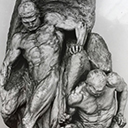0269 Altering the Titles of Artworks for New Functions. Two Plaster Groups by Josip Urbanija (1877–1943)
Identifiers (Article)
Abstract
Slovenian sculptor Josip Urbanija (1877–1943) received his initial training in workshops in Ljubljana, Selce pri Škofji Loki and Klagenfurt, then he studied with Hans Bitterlich at the Academy of Fine Arts in Vienna shortly before the First World War. He spent the war years in Bosnia, where he completed two monuments. After the dissolution of the Habsburg Monarchy, he settled permanently in Vienna. This is partly the reason why his life and work have hardly been researched and are almost unknown. The aim of the present study is to provide insight into the origin of two monumental sculptural groups initially named Quelle (Water Spring) and Tunnelbrecher (Tunnel Breaker). In addition, it also discusses later names of the two plaster artworks and examines what they reveal about the intended functions of the sculptures.
Statistics


License

This work is licensed under a Creative Commons Attribution-NonCommercial-NoDerivatives 4.0 International License.



